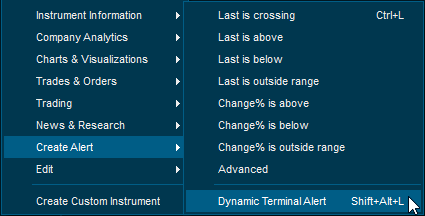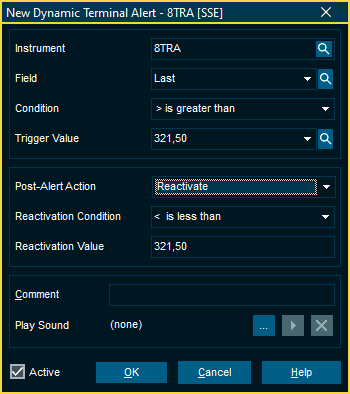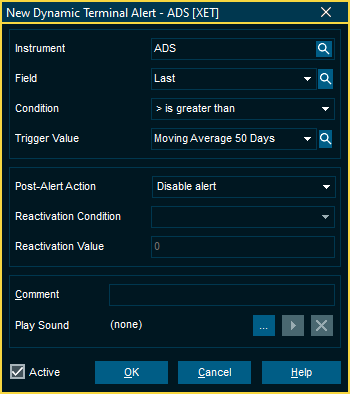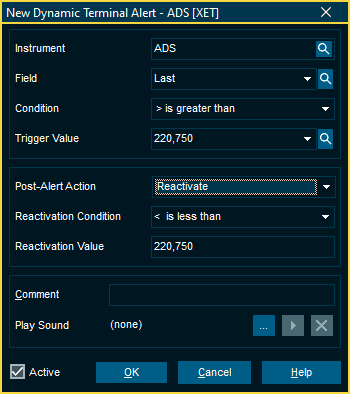Dynamic Terminal Alerts
Overview
The new Dynamic Terminal Alerts includes comprehensive improvements and enhancements of the alert functionality in the Infront Professional Terminal. Whether you are tracking changes in price, market volume, technical indicators or news, the new alerting solution helps you stay informed and up to date on important changes in the market.
Field-to-Field Comparison - Create real-time alerts that compare two continuously updating instrument fields from any instrument within the Infront universe, notifying you when the comparison meets your specified condition. The enhanced alerting feature enables you to track both short- and long-term trends, such as when the last traded price of an instrument exceeds its bid, or when the 50-day moving average crosses the 100-day moving average.
Create Alerts Using Any Instrument Field - Dynamic Terminal Alerts support comparisons for all available fields, allowing the monitoring of, for instance, trading halts, breaking news or technical indicators.
Recurring alerts - Automatically reactivate alerts when specific market conditions are met, ensuring that you are notified each time a threshold is breached throughout the day without requiring any manual resets.
Order entry alerts - Automatically generate a price range alert, relative to the price of submitted buy and sell orders, helping you stay on top of your positions and adjust strategies as needed.
The Dynamic Terminal Alert feature allows you to create real-time alerts based on comparisons of different instrument fields. The alerts notify you when specific conditions are met, allowing greater control and flexibility for tracking market data and making informed trading decisions.
Accessing the Dynamic Terminal Alert Window

To open the Dynamic Terminal Alert window, right-click on an instrument, navigate to the Create Alert menu, and select Dynamic Terminal Alert.
Alternatively, you can press Shift + Alt + L to open the alert window directly.
Input parameters of Dynamic Terminal Alerts
Instrument
The Instrument field will automatically populate with the instrument selected when the window was opened.
To select a different instrument, type into the Instrument field or click the magnifying glass icon to search for an instrument in the Infront Universe.

Field
The Field input is where you specify the instrument field to be compared to the Trigger Value.
Click on the dropdown arrow to select available fields from a menu or on the magnifying glass to search for additional fields such as Moving Average, Symbol Status, or other available data fields for the selected instrument.
Condition
The Condition field defines how the selected field is compared to the trigger value.
Available conditions depend on the type of data in the selected field:
News fields: Condition is always set to "When news arrives"
Text fields: Options include Contains, Does not Contain, Matches, and Does not Match.
Numerical fields: Conditions include Greater than, Greater or equal, Less than, Less or equal, and Equals.
Trigger Value
The Trigger Value field is automatically populated with the current value of the selected field.
If the selected Field is numeric, you can create a dynamic comparison by selecting an instrument field from the dropdown or by clicking the magnifying glass to search for an instrument field to use as the trigger.

The condition for this alert will be triggered when the instrument ADS has a Last value greater than its Moving Average 50 Days.
Post-Alert Action
The Post-Alert Action determines what happens once the alert is triggered:
None: No additional action. The alert stays active and will trigger again if the condition is met.
Focus Application: Brings the application into focus.
Disable Alert: Deactivates the alert after it is triggered.
Delete Alert: Removes the alert once it is triggered.
For News Alerts, the Story Window can be set to open automatically when triggered.
Reactivate: Allows the alert to be triggered again if the Reactivation Condition has been met.
Reactivation and Recurrence
When Post-Alert Action is set to Reactivate, the Reactivation Condition is automatically populated with the opposite of the original alert condition. For example, if the original condition is Last is greater than X, the reactivation condition will be Last is less than X.
The Reactivation Value specifies the threshold at which the alert reactivates. When this condition is met, the alert can trigger again, allowing continuous monitoring of a specific instrument or trend.

The Condition of this alert is “> is greater than”, the automatically populated Reactivation Condition is therefore “< is less than”.
Additional Settings
Comment: Add optional comments to clarify the purpose of the alert or provide additional information.
For generated Order Entry Alerts, the comment includes ‘Buy' or 'Sell’ and the corresponding price of the order by default.
Play Sound: Select an audio notification to accompany the alert, ensuring that important alerts catch your attention.
